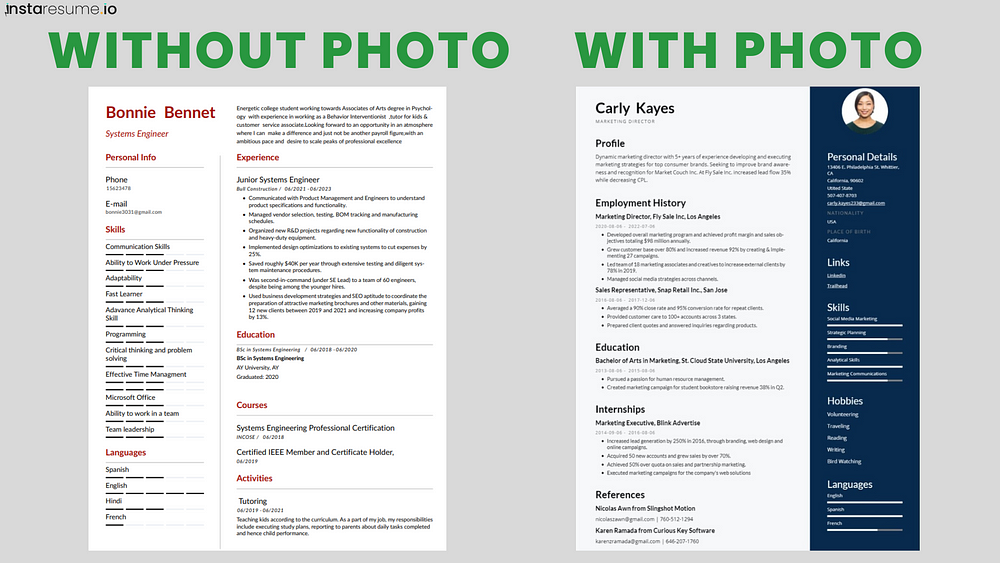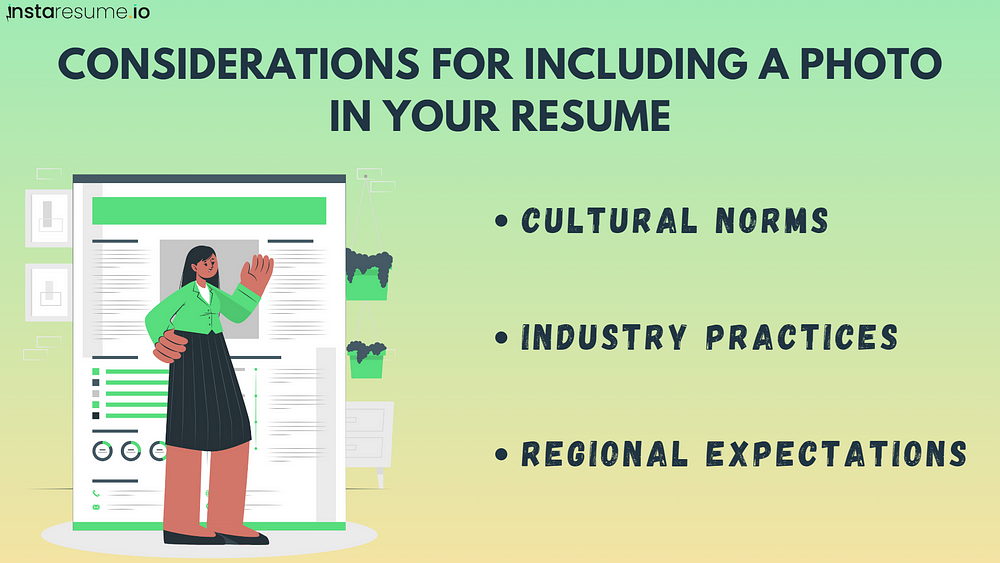Is it good to add a photo in your resume?
The decision to include a photo in a resume is a topic of ongoing debate. While some argue that a photo adds a personal touch and enhances visual appeal, others raise concerns about potential bias and discrimination. In this blog post, we will delve into the pros and cons of adding a photo to your resume. By considering both perspectives, you can make an informed decision that aligns with your personal branding and maximizes your chances of success in the job market.
Including a photo in your resume can be a complex decision that depends on various factors, including cultural norms, industry practices, and regional expectations. Understanding these factors is crucial to making an informed choice that aligns with your target job market.

Resumes created on Instaresume.io
Pros of Including a Photo in Your Resume
1) Personal Branding and Visual Impact:
Including a professional headshot allows you to showcase your personal branding and make a memorable impression on potential employers. A visually appealing resume can capture attention and create a positive initial impression, helping you stand out from other applicants.
2) Cultural Relevance and Expectations:
In some countries and industries, it is customary to include a photo in a resume. Adhering to these cultural expectations demonstrates your familiarity with local customs and professionalism, potentially resonating with employers who value such practices.
3) Increased Authenticity and Connection:
A well-chosen photo can add a human touch to your resume, allowing hiring managers to connect a face to your qualifications and experiences. It helps create a sense of authenticity and can foster a stronger connection between you and the reader.
Cons of Including a Photo in Your Resume
1) Potential for Bias and Discrimination:
One of the main concerns about including a photo in a resume is the potential for unconscious bias and discrimination. Human beings are susceptible to forming judgments based on appearances, which can lead to unfair evaluations and hinder equal opportunities in the hiring process.
2) Legal and Regulatory Considerations:
In some jurisdictions, employers are legally restricted from making hiring decisions based on physical attributes. Including a photo in your resume may expose companies to legal risks if a candidate believes they were discriminated against due to appearance-related biases.
3) Focus on Qualifications and Experience:
A resume's primary purpose is to highlight your qualifications, skills, and experiences relevant to the job. Including a photo may divert attention away from these essential elements and shift the focus to your appearance, potentially diminishing the importance of your professional achievements.
Considerations for Including a Photo in Your Resume

Considerations for Including a Photo on Instaresume.io
Cultural norms
It plays a significant role in determining whether a photo is appropriate in a resume. For example, in countries like the United States and Canada, it is generally not expected or recommended to include a photo. Hiring decisions in these regions are expected to be based solely on qualifications, skills, and experiences. In fact, including a photo in these contexts may inadvertently introduce the potential for bias or discrimination based on appearance, gender, or race.
Mind your Industry:
Consider the industry and position you are applying for. Some industries, such as modelling, acting, or customer-facing roles, may require or benefit from a professional photo as it provides a visual representation of your appearance and presentation skills. However, for most professional roles in industries like finance, technology, or administration, a photo is typically not necessary and may not contribute significantly to the hiring decision.
Decide on the basis of the region in which you are looking for a job:
In some countries and regions, such as parts of Europe or Asia, it is more common or even expected to include a professional photo on your resume. In these cases, it is crucial to adhere to cultural norms and expectations. Researching and understanding the practices specific to your target country or region can help you make an informed decision.
It's important to be mindful of potential bias and discrimination when considering whether to include a photo. Hiring decisions should be based solely on qualifications and skills, promoting fairness and equal opportunities. By omitting a photo, you help ensure that the focus remains on your qualifications, experiences, and capabilities rather than personal attributes.
Instead of including a photo, focus on presenting your skills, experiences, and qualifications through a well-structured and visually appealing resume format. Emphasize essential sections such as a summary or objective, work experience, education, and relevant skills. If you want to showcase your appearance or personal brand, consider including a link to your professional online presence, such as a LinkedIn profile or personal website. This allows potential employers to explore your profile and get a better understanding of your professional qualifications and achievements.
Ultimately, it's crucial to research and understands the expectations and norms within your target industry and region. Adapt your resume accordingly to align with these expectations. When in doubt, it is generally safer to omit the photo and focus on presenting a professional, well-crafted resume that highlights your qualifications and experiences effectively.
Conclusion:
When deciding whether to include a photo in your resume, consider the cultural context, industry norms, and your comfort level with potential biases. A strategically placed photo can humanize your application, tell a visual story, and align with cultural expectations. However, it's crucial to remain aware of the risks associated with unconscious bias, discrimination, and legal considerations.
Ultimately, you must strike a balance that reflects your personal branding while maintaining professionalism.Focus on crafting a well-structured resume that highlights your qualifications, skills, and achievements. If you decide to include a photo, ensure it portrays your authentic self and complements the overall narrative of your application. Remember, your resume is a powerful tool to showcase your professional journey, and the decision to include a photo should align with your values and aspirations. you can create well-structured resume for free on our website and do unlimited downloads.

